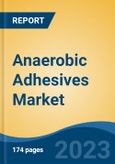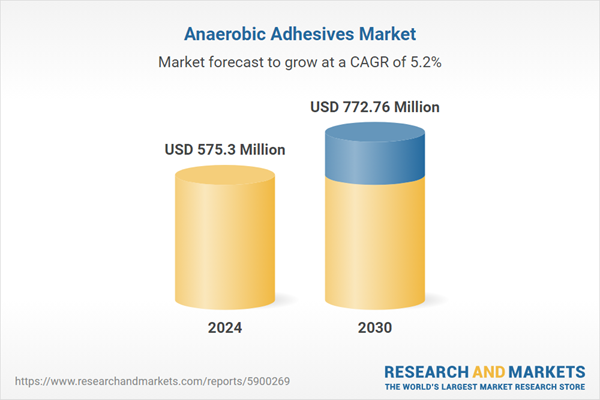Speak directly to the analyst to clarify any post sales queries you may have.
10% Free customizationThis report comes with 10% free customization, enabling you to add data that meets your specific business needs.
Their role in enhancing performance and reliability in high-stress applications makes them indispensable. Anaerobic adhesives cure between closely fitted metal parts, delivering resistance to vibration, shock, and thermal variations. With rising environmental regulations and a global shift toward sustainable practices, their low-VOC emissions and long-lasting functionality position them as environmentally responsible bonding solutions. These qualities are contributing to broader adoption, particularly in markets emphasizing green chemistry and eco-compliance.
Key Market Drivers
Increasing Demand for High-Performance Adhesives
The expanding requirement for advanced, high-performance bonding solutions across industries is a primary driver of growth in the global anaerobic adhesives market. Anaerobic adhesives offer unmatched bonding strength in oxygen-deprived settings, making them critical in applications where durability and reliability are essential. A key contributor to this trend is the rise in global industrialization, where manufacturing and mechanical assembly require adhesives that can perform under extreme operating conditions. Companies like Arkema have emphasized their commitment to high-performance and sustainable adhesive technologies, highlighting a broader industry trend. Although distinct from anaerobic adhesives, Arkema's innovations reinforce the increasing demand for specialized bonding products. As industrial sectors evolve and diversify, anaerobic adhesives are emerging as preferred solutions due to their resistance to stress, temperature changes, and mechanical loads.Key Market Challenges
Competition from Other Types of Adhesives
The anaerobic adhesives market faces considerable pressure from alternative adhesive technologies that cater to different applications. Adhesives such as cyanoacrylates, known for their rapid bonding, and epoxies, valued for their strength and versatility, present strong competition. Additionally, as global regulations push for lower environmental impact, water-based and solvent-free adhesives are gaining traction due to their eco-friendly profiles. These trends have placed anaerobic adhesives in a competitive landscape where differentiation and application-specific value are crucial. To remain relevant, manufacturers must focus on innovation - emphasizing advantages such as thermal resistance and superior sealing - and increase market awareness around the specific use cases where anaerobic adhesives offer irreplaceable performance benefits.Key Market Trends
Increasing Demand for Water-Based Anaerobic Adhesive
A notable trend in the anaerobic adhesives market is the growing interest in water-based formulations, driven by a collective move toward sustainability and safety. These adhesives reduce VOC emissions and pose fewer health hazards, making them more attractive in environmentally regulated industries. An example of this trend is the Permabond A131 adhesive, which provides effective sealing for threaded metal pipes carrying various liquids and gases, including potable water. Such products highlight the capacity of water-based anaerobic adhesives to deliver high performance while supporting environmental and regulatory goals. As industries continue to prioritize green chemistry, the adoption of water-based alternatives is expected to grow steadily, expanding the market’s eco-conscious segment.Key Market Players
- Henkel AG & Co.
- DELO
- 3M Company
- Permabond LLC
- Kisling AG
- Royal Adhesives & Sealants
- ThreeBond Holdings Co. Ltd.
- H.B. Fuller Co.
- Nitto Denko Corporation Permabond LLC
- Anabond Limited
Report Scope:
In this report, the Global Anaerobic Adhesives Market has been segmented into the following categories, in addition to the industry trends which have also been detailed below:Anaerobic Adhesives Market, By Adhesive Type:
- Acrylic
- Silicone
- Butyl
- Others
Anaerobic Adhesives Market, By Substrate Type:
- Plastic
- Rubber
- Metal
- Others
Anaerobic Adhesives Market, By Application:
- Thread Sealants
- Retaining Compounds
- Gasket Sealants & Flange Sealants
- Anaerobic Thread Lockers
Anaerobic Adhesives Market, By End User:
- Automotive
- Healthcare
- Building & Construction
- Electrical & Electronics
- Packaging
- Others
Anaerobic Adhesives Market, By Region:
- Asia Pacific
- China
- India
- Japan
- Australia
- South Korea
- North America
- United States
- Canada
- Mexico
- Europe
- France
- United Kingdom
- Italy
- Germany
- Spain
- South America
- Brazil
- Argentina
- Colombia
- Middle East & Africa
- South Africa
- Saudi Arabia
- UAE
Competitive Landscape
Company Profiles: Detailed analysis of the major companies present in the Global Anaerobic Adhesives Market.Available Customizations:
With the given market data, the publisher offers customizations according to a company's specific needs. The following customization options are available for the report.Company Information
- Detailed analysis and profiling of additional market players (up to five).
This product will be delivered within 1-3 business days.
Table of Contents
Companies Mentioned
- Henkel AG & Co.
- DELO
- 3M Company
- Permabond LLC
- Kisling AG
- Royal Adhesives & Sealants
- ThreeBond Holdings Co. Ltd.
- H.B. Fuller Co.
- Nitto Denko Corporation Permabond LLC
- Anabond Limited
Table Information
| Report Attribute | Details |
|---|---|
| No. of Pages | 185 |
| Published | June 2025 |
| Forecast Period | 2024 - 2030 |
| Estimated Market Value ( USD | $ 575.3 Million |
| Forecasted Market Value ( USD | $ 772.76 Million |
| Compound Annual Growth Rate | 5.2% |
| Regions Covered | Global |
| No. of Companies Mentioned | 10 |









